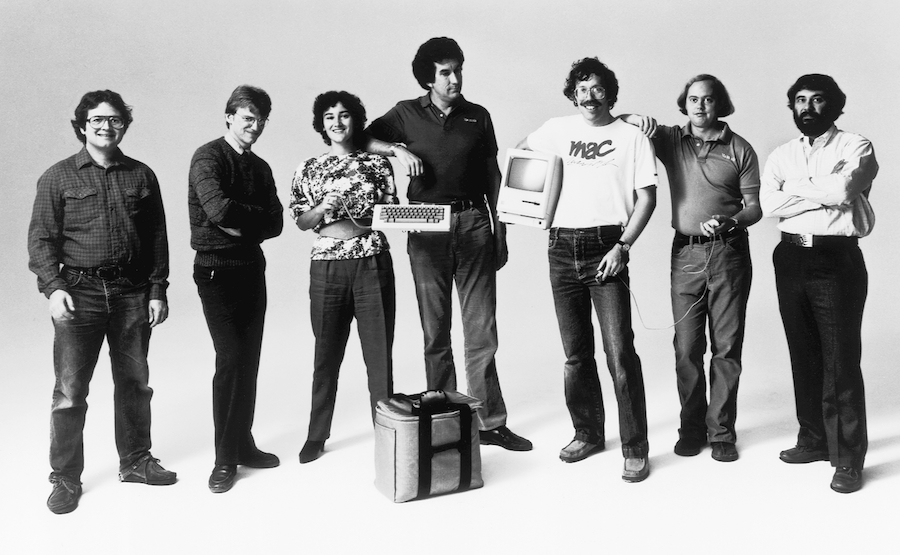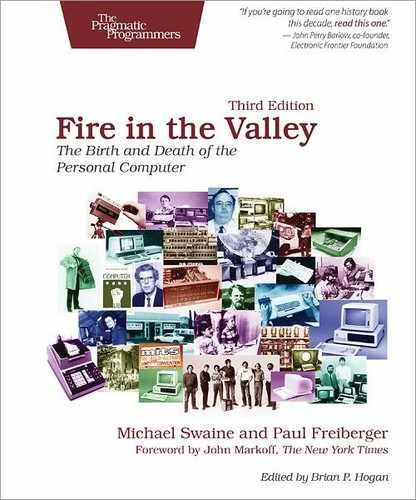Losing Their Religion
We found ourselves a big company, glutted from years of overspending. Then the money supply dried up, and that caused the first of a series of convulsions.
–Chris Espinosa, employee no. 8 at Apple Computer
In the 1980s Steve Jobs’s dream machine became reality. And market reality can be brutal.
The Mac’s Shortcomings
After the release of the Macintosh in 1984, Steve Jobs felt vindicated. Plaudits from the press and an immediate cult following assured him that the machine was, as he had proclaimed it, “insanely great.” He had every right to take pride in the accomplishment. The Macintosh would never have existed if it hadn’t been for Jobs. He had seen the light on a visit to Xerox PARC in 1979. Inspired by the innovations presented by the PARC researchers, he longed to get those ideas implemented in the Lisa computer. When Jobs was nudged out of the Lisa project, he hijacked a team of Apple developers working on an interesting idea for an appliance computer and turned them into the Macintosh skunk works.
Jobs hounded the people on the Macintosh project to do more than they thought possible. He sang their praises, bullied them mercilessly, and told them they weren’t making a computer; they were making history. He promoted the Mac passionately, making people believe that he was talking about much more than just a piece of office equipment.
His methods all worked, or so it seemed. Early Mac purchasers bought the Jobs message along with the machine, and forced themselves to overlook the little Mac’s serious shortcomings. For about three months, Mac sales more or less measured up to Jobs’s ambitious projections. For a while, reality matched the image in Steve Jobs’s head.
Then Apple ran out of zealots.

Figure 89. Andy Hertzfeld After Jobs pulled him off Apple II development, Hertzfeld wrote the key software for the Macintosh.
(Courtesy of Andy Hertzfeld)

Figure 90. The Mac design team Left to right: Andy Hertzfeld, Chris Espinosa, Joanna Hoffman, George Crow, Bill Atkinson, Burrell Smith, Jerry Manock (Courtesy of Apple Computer Inc.)
The first Macintosh purchasers were early adopters—technophiles willing to accept the inevitable quirks of new technologies for the thrill of being the first to use them. Those early adopters all bought Mac machines in the first three months of sales, and then the well dried up. In 1984 and 1985, the first two years of the Mac’s life, sales routinely failed to reach the magnitude of Jobs’s expectations—sales projections that the company was counting on. For those two years, it was the old reliable Apple II that kept the company afloat. If Apple had depended on Mac sales alone, it would have folded before the 1980s were over.
All the while, the Mac team still got the perks, the money, and the recognition, and the Apple II staff got the clear message that they were part of the past. Jobs told the Lisa team outright that they were failures and “C players.” He called the Apple II crew “the dull and boring division.”
Chris Espinosa came to the Mac division from the Apple II group. He had family and friends still on the Apple II side. The 20-year-old Espinosa had worked at Apple since he was 14. The us-versus-them syndrome he witnessed saddened him.
Customers, third-party developers, and Apple stockholders weren’t all that happy, either. The Mac wasn’t selling slowly for lack of an advertising budget. It deservedly failed in the market. It lacked some essential features that users had every reason to demand. Initially, it had no hard-disk drive, and a second floppy-disk drive was an extra-price option. With only a single disk drive, making backup copies of files was a nightmare of disk-swapping.
At 128K RAM, it seemed that the Mac’s memory should have been more than adequate; 64K was the standard in the industry. But the system and application software ate up most of the 128K, and it was clear that more memory was needed. Dr. Dobb’s Journal ran an article showing how anyone brave enough to attack the innards of their new Mac machine with a soldering iron could “fatten” their Mac to 512K, six months before Apple got around to delivering a machine with that much RAM.
But the memory limitations weren’t a problem unless you had the software that used the RAM, and therein was the real problem. The Mac shipped with a collection of Apple-developed applications that allowed users to do word processing and draw bitmapped pictures. Beyond that, the application choices were slim because the Mac proved to be a difficult machine to develop software for.
The Departure of Steve Jobs
Jobs was entirely committed to his vision of the Macintosh, to the point that he continued to use the 10-times-too-large sales projections as though they were realistic. To some of the other executives, it began to look like Jobs was living in a dream world of his own. The Mac’s drawbacks, such as the lack of a hard-disk drive, were actually advantages, he argued, and the force of his personality was such that no one dared to challenge him.
Even his boss found it difficult to stand up to Jobs. John Sculley, whom Jobs had hired from Pepsi to run Apple, concluded that the company couldn’t afford to have its most important division headed up by someone so out of touch with reality. But could Sculley bring himself to demote the founder of the company? The situation was getting critical: early in 1985, the company posted its first-ever quarterly loss. Losses simply weren’t in the plan for Apple, which stood as an emblem of the personal-computer revolution, a modern-day legend, and a company that had risen to the Fortune 500 in record time.
Sculley decided to take drastic action. In a marathon board meeting that began on the morning of April 19, 1985, and continued into the next day, he told the Apple board that he was going to strip Jobs of his leadership over the Mac division and any management role in the company. Sculley added that if he didn’t get full backing from the board on his decision, he couldn’t stay on as president. The board promised to back him up.
But Sculley failed to act on his decision immediately. Jobs heard about what was coming, and in a plot to get Sculley out, began calling up board members to rally their support. When Sculley heard about this, he called an emergency executive board meeting on May 24. At the meeting he confronted Jobs, saying, “It has come to my attention that you’d like to throw me out of the company.”
Jobs didn’t back down. “I think you’re bad for Apple,” he told Sculley, “and I think you’re the wrong person to run the company.” The two men left the board no room for hedging. The individuals in that room were going to have to decide, then and there, between Sculley and Jobs.
They all got behind Sculley. It was a painful experience for everyone involved. Apple II operations manager Del Yocam, for one, was torn between his deep feelings of loyalty toward Jobs and what he felt was best for the future of the company. Yocam recognized the need for the grown-up leadership at Apple that Sculley could supply and that Jobs hadn’t, and he cast his vote for maturity over vision.
Jobs was understandably bitter. In September, he sold off his Apple stock and quit the company he had cofounded, announcing his resignation to the press. The charismatic young evangelist who had conceived the very idea of Apple Computer, had been the driving force behind getting both the Apple II and the Macintosh to market, had appeared on the cover of every major newsmagazine, and was viewed as one of the most influential people in American business was now out the door.
